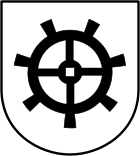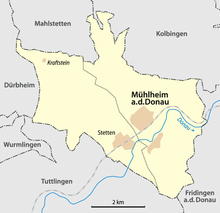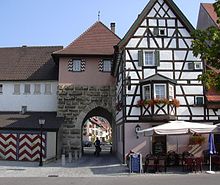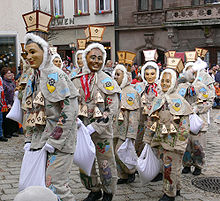Mühlheim on the Danube
| coat of arms | Germany map | |
|---|---|---|

|
Coordinates: 48 ° 2 ' N , 8 ° 53' E |
|
| Basic data | ||
| State : | Baden-Württemberg | |
| Administrative region : | Freiburg | |
| County : | Tuttlingen | |
| Local government association: | Danube Heuberg | |
| Height : | 664 m above sea level NHN | |
| Area : | 21.73 km 2 | |
| Residents: | 3607 (Dec. 31, 2018) | |
| Population density : | 166 inhabitants per km 2 | |
| Postal code : | 78570 | |
| Area code : | 07463 | |
| License plate : | DOES | |
| Community key : | 08 3 27 036 | |
| LOCODE : | DE F7W | |
City administration address : |
Hauptstrasse 16 78570 Mühlheim an der Donau |
|
| Website : | ||
| Mayor : | Jörg Kaltenbach ( CDU ) | |
| Location of the city of Mühlheim an der Donau in the Tuttlingen district | ||
Mühlheim an der Donau is a small town in the Tuttlingen district in Baden-Württemberg ( Germany ).
geography
Geographical location
Mühlheim an der Donau is located in the heart of the Obere Donau Nature Park around ten kilometers northeast of the district town of Tuttlingen . In the Stetten district to the west of Mühlheim, the Kesselbach flows into the Danube . In the area of the old town the Lippach flows , and close to the eastern edge of the district the Wulfbach .
Neighboring communities
In a clockwise direction , neighboring communities in Mühlheim are Mahlstetten , Kolbingen , Fridingen an der Donau and the Tuttlingen district of Nendingen . The Mühlheim district also touches the districts of a total of four neighboring communities (in addition to Nendingen there are Wurmlingen , Dürbheim and Rietheim-Weilheim ) at a single point in Ursental .
City structure
The city of Mühlheim an der Donau has been made up of the districts of Mühlheim and Stetten since it was incorporated in 1971 . The district of Stetten is officially listed as " Mühlheim an der Donau-Stetten ". The districts are spatially identical to the earlier communities of the same name.
The district of Mühlheim consists of the town of Mühlheim an der Donau , the hamlet of Altstadt , the courtyards Kraftstein , Mittlere Mühle and Obere Mühle as well as the Schützenwirtshaus, which was demolished in 1978, and the Kraftstein castle ruins . Only the village of Stetten an der Donau belongs to the district of Stetten .
| coat of arms | District | Population (as of August 2009) |
surface |
|---|---|---|---|
| Mühlheim an der Donau (core town) | 2750 | 1178 ha | |
| Stetten | 730 | 995 ha |
history
Ancient and early Middle Ages
The history of the city of Mühlheim goes back at least to Roman times , when the first mill wheels were built on the two karst springs of the Wulfbach on the left side of the Danube, in the area of today's old town . These springs provided enough water for the mill wheels and the subsequent settlement all year round. The central importance of the mills made them the namesake of the settlement. The further development of Mühlheim was favored by an old trade route that came from Lake Constance and crossed the Danube in a ford near Mühlheim and then continued over the Swabian Alb to Rottweil . A church dedicated to St. Gallus was built above the ford in the 8th century . It is not known exactly what significance Mühlheim had at that time, but it can be considered certain that the church was significant not only for Mühlheim but also for some neighboring villages. The first documentary mention of Mühlheim dates back to 843.
High and late Middle Ages
In the 12th century Mühlheim came into the possession of the noble family von Zollern . Shortly after 1200 Friedrich IV. Von Zollern founded a castle on a mountain spur south of the Danube, called Nussbühl . This was soon followed by a fortified city with four gates. Several noble families, including a branch of the von Werenwag family , chose Mühlheim as their place of residence at this time. The old trade route had meanwhile become the Reichsstrasse and favored the development of weekly and annual markets. Mühlheim thus developed into a regional economic center.
The Counts of Zollern made Mühlheim the administrative center of the Mühlheim rule by acquiring several villages and, above all, by obtaining the bailiwick of the Beuron monastery . At the end of the 14th century, the city tried to create its own territory based on the model of the imperial cities. In 1386, for example, the mayor Peter the Spreter bought Kraftstein Castle , but the city was unable to make another acquisition.
Mühlheim was then sold twice, first in 1392 to the Lords of Weitingen and 17 years later to the Lords of Enzberg , who had resided in Mühlheim since 1409. The decline of the city, which began at the end of the Middle Ages, was accelerated by the departure of several important families due to a constitutional conflict between the citizens and their new city lords in the second half of the 15th century.
Early modern age
The decisive factor for the disadvantageous development of the city was the shift of traffic to the road that led from Lake Constance via Tuttlingen to Rottweil. Mühlheim lost its importance and in the shadow of Tuttlingen it became a tranquil country town. From then on, the citizens of Mühlheim lived mainly from agriculture and from a few local handicraft businesses.
The decline of the place was sealed by the Thirty Years' War , during which Mühlheim was repeatedly occupied by imperial and Swedish troops. In 1632 300 Swedes are said to have been killed in an attack. A Swedish grave on the Danube still commemorates this bloodbath today. The war brought great suffering to the city; of the original 96 citizens with their families, only 28 lived in the city in 1635. The rest had fled, starved or succumbed to an epidemic.
In his chronicle, the then mayor Bartholomäus Kindler describes the fate that befell the city. The city hardly recovered from this stroke of fate and almost sank into insignificance in the 18th century.
Württemberg time
In 1806 Mühlheim came under the rule of Baden for a short time due to the Rhine Confederation Act and its location to the right of the Danube, but in the same year it came to the Kingdom of Württemberg with the exchange and epuration treaty and was assigned to the Oberamt Tuttlingen . The industrial revolution at the end of the 19th century also affected Mühlheim and gradually brought modest prosperity back to the town. During this time, watch factories were founded, for example by Ruprecht Amman and Karl Aigeltinger.
The construction of the Tuttlingen – Inzigkofen railway by the Württemberg State Railways in 1890 provided further impetus . In the same year, a city fire caused considerable damage.
In 1896 the watchmaker Ludwig Leibinger founded a workshop for surgical instruments. In the following years, other craft and industrial companies settled in the suburb.
During the administrative reform in Württemberg during the Nazi era , Mühlheim came to the Tuttlingen district in 1938 .
post war period
After the Second World War, Mühlheim was part of the French occupation zone and thus became part of the newly founded state of Württemberg-Hohenzollern in 1947 , which was dissolved in the state of Baden-Württemberg in 1952.
As a result of structural expansions, which have mainly taken place in the suburbs since the 1950s, today, as in Roman times, most of the city is located on the left of the Danube, after the center of Mühlheim was in the upper town on the right of the Danube in the Middle Ages.
With the district reform in Baden-Württemberg , the city of Mühlheim moved as part of the district of Tuttlingen from the administrative district of Südwürttemberg-Hohenzollern to the administrative district of Freiburg .
The city of Mühlheim received a secondary school in 1979 and in 1987 gained representative rooms for cultural events through the acquisition of the Vordere Schloss from Freiherr von Enzberg. In the Near Schloss Mühlheim set up a museum. Many of the historic half-timbered buildings in the Upper Town have been restored and the historic townscape has been restored, with the town hall , which presumably dates back to the 14th century, at its center .
Incorporations
On December 1, 1971, the previously independent community of Stetten an der Donau (so since January 27, 1962, previously Stetten ) was incorporated.
politics
Local council and local councils
The two parts of the city form residential districts within the meaning of the Baden-Württemberg municipal code and in the Stetten district a locality within the meaning of the Baden-Württemberg municipal code has been set up with its own local council and mayor as its chairman.
The local elections on May 26, 2019 led to the following result with a turnout of 68.6% (+ 10.5% p):
| Party / list | Share of votes | +/-% p | Seats | +/- |
| Citizen List | 76.2% | + 13.6 | 11 | + 2 |
| SPD | 23.8% | - 13.6 | 3 | - 2nd |
mayor
Mayor of the city of Mühlheim an der Donau is Jörg Kaltenbach.
- 1966–1994: Kurt Weiss (CDU)
- 1994-2005: Oliver Ehret (CDU)
- since 2006: Jörg Kaltenbach (CDU)
Administrative association
Mühlheim is a member of the community administration association Donau-Heuberg based in Fridingen an der Donau .
coat of arms
| Blazon : "A four-spoke black mill wheel in silver ." | |
| Justification for the coat of arms: The coat of arms is derived from the city's oldest seal from 1266. It already shows the mill wheel that " speaks " for the place name . The colors silver and black are the Zollers in memory of the founding of the city by the Counts of Zollern . |
- The fire brigade Mühlheim & Stetten an der Donau has a coat of arms on its vehicles, the shield of which is divided obliquely to the left by blue and gold (yellow).
Banner and flag
 |
Banner: "The banner is blue and white striped lengthways with the coat of arms above the middle." |
 |
Hoisted flag: "The flag has blue and white stripes with the coat of arms in the middle." |
Culture and sights
The municipality is affiliated with the "Donaubergland" tourist association.
museum
- The museum is located on the two upper floors of the front castle. The building was acquired by the city of Mühlheim in 1987 from the Freiherr von Enzberg, who had lived here since 1409, and was completely restored. In its current form, it dates from the middle of the 18th century. The focus of the museum concept is on the history of the city and the former rule of Mühlheim, the church and the Welschenberg. The permanent exhibition takes up topics from art and cultural history as well as church and social history.
City Hall
The festival hall and the community center in the Stetten district are available for theater and concert events. These facilities were supplemented by the community center in the Stetten district. Regular lectures are held here under the leadership of the Friends' Association.
Buildings
- The impressive Maria Hilf church ruins on Welschenberg were built in 1661 and demolished in 1813. It was a well-known place of pilgrimage. The pilgrimage began after the Thirty Years War when the pastor of Mühlheim put a picture of the Virgin Mary on a large oak tree in 1649 . In later years hostels for pilgrims and stables were even built. In 1756 the pilgrimage peaked with the construction of a new church, which was 47 m long and 18 m wide. In 1811 the pilgrimage was officially canceled and the buildings were sold for demolition. Today there is still a large ruined church, of which the church tower was restored and part of the church was given a roof.
- The Galluskirche is the Mühlheimer Friedhofskirche. Parts of the structure of the Romanesque-style building date from the 10th and 11th centuries. Inside you can see frescoes from the 14th to 15th centuries. The organ from 1759 is one of the last surviving works by the organ builder Hieronymus Spiegel from Fridingen an der Donau.
- The Sebastian Chapel dates back to 1610, when the last citizen died in a devastating plague epidemic and a vow of the survivors led to the building of the church. The plague chapel is dedicated to Saints Sebastian and Rochus. Above the arched gate there is a relief of Saint Sebastian with the foundation year 1610.
- The town hall is a Gothic half-timbered building that was added to the list of architectural monuments in 1928 . The town hall was first mentioned in 1512, but a column with a Romanesque capital indicates that it was founded around 1200.
- The castle (also "rear castle") of the Lords of Enzberg was built around 1200; It got its present appearance in the middle of the 18th century. The castle was named " Monument of the Month July 2019" by the Monument Foundation Baden-Württemberg .
Natural monuments
- The Mühlheimer Felsenhöhle was opened up in 1912, but is usually closed and cannot be visited.
- The Yellow Rock is a lookout point over the Danube Valley.
- East of Mühlheim have, in a backwater of the Danube (Wulfbach) which is directly adjacent to an embankment and is connected by a stream with the Danube beaver located; an information board on the Danube Cycle Path provides information about the beavers and the nature reserve.
Regular events
Mühlheim is a stronghold of the Swabian-Alemannic carnival . The fools guild Mühlheim / Donau e. V. with its fool figures "Schellennarr" and "Kea-Weib" is a member of the Association of Swabian-Alemannic Fools' Guilds (VSAN). On the afternoon of Carnival Monday, there is a carnival parade in Mühlheim in the historic Upper Town. Already in the morning the traditional and in this form unique Rü use “Says he” is performed on the streets. A lead singer describes curiosities of the past year. Each of his accusatory verses is confirmed by about 200 "Says He-Men" in white shirts and black pointed hats standing in a circle around him, nodding their heads and chanting the words "Says he". Balthasar Leibinger brought the idea for this carnival game, introduced in 1892, with him from a visit to Berlin in 1890. There he had seen the singspiel “A Viennese in Berlin”, which contained a corresponding musical number.
In addition to numerous regular events of the associations, it is above all the cultural office and the voluntary culture group that offer various events throughout the year. The cultural office presents the series “Culture in Mühlheim” with the palace garden concert, cabaret artists, comedians, bands and choirs as well as readings. The voluntary culture group offers special events such as the classic series “Home Games” or cooperation with the cultural office, the support association “Stetten - Encounters in the Village” and the TheaterBahnhof Mühlheim . At longer intervals there is also a long culture night with many actors at an event.
Other Events:
- The city festival takes place every two years on the first weekend in September.
- The “Great Market Day” (Ulrichsmarkt and flea market) takes place every year on the second Sunday in June. Also on October 30th (if not a Sunday) the traditional Thomas market.
Economy and Infrastructure
Known companies
More than 100 companies have their headquarters in Mühlheim. Karl Leibinger Medizintechnik is the largest local employer with 335 employees. The family company, which has existed since 1896, is a leading manufacturer of surgical instruments and is now part of the KLS Martin Group .
traffic
Mühlheim is on the Tuttlingen – Inzigkofen railway line and is connected to the Ringzug system that connects the place with Fridingen and Tuttlingen . Occasional trains also run to Sigmaringen . Mühlheim belongs to the TUTicket transport association .
The busy Danube Cycle Path runs through Mühlheim .
Educational institutions
In addition to the communal kindergarten in the Stetten district, there are also three denominational kindergartens. Mühlheim has a primary school and a secondary school. Mühlheim is a branch of the Adult Education Center and the Tuttlingen Music School.
Leisure and sports facilities
- Indoor swimming pool with sauna
- Sports area on the Ettenberg
- Ski slope with lift system
- Lippachtal children's playground with bird and nest box educational trail and Riedbrunnen playground in the Stetten district
Supply networks
Mühlheim has its own water supply. The wastewater is cleaned by the Donautal - Heuberg wastewater association based in Mühlheim and fed into the Danube. The local power grid is owned by EnBW, the natural gas supply is owned by badenova AG & Co. KG in Freiburg. Together with badenova AG & Co. KG, Mühlheim founded an energy company Mühlheim mbh & Co. KG and implemented a local heating supply network.
Personalities
- Caspar II. Thoma († 1596), was abbot of the St. Blasien monastery from 1571 to 1596
- Ignaz Ambros von Amman (1753-1830 or 1840), cartographer and national geometer
- Karl Anton Gutknecht (1859–1928), politician (DNVP), member of the Reichstag
- Josef Alfons Wirth (1887–1916), painter and draftsman
- Nikolaus Freiherr von Enzberg (1911–1976), District Administrator of Rottweil
- Fritz Buschle (* 1951), SPD politician (MdL), municipal councilor in Mühlheim since 1980
- Oliver Ehret (* 1964), CDU politician, Mayor of Mühlheim between 1994 and 2005, Lord Mayor of Singen (Hohentwiel) from 2005 to 2013
The Korb family of artists from Mühlheim designed numerous sacred buildings throughout the area in the 17th and 18th centuries .
literature
- Elmar Blessing: Mühlheim on the Danube. History and stories of a city. Jan Thorbecke Verlag, Sigmaringen 1985, ISBN 3-7995-4078-4 .
Individual evidence
- ↑ State Statistical Office Baden-Württemberg - Population by nationality and gender on December 31, 2018 (CSV file) ( help on this ).
- ^ Mühlheim on the Danube . In: The state of Baden-Württemberg. Official description by district and municipality. Volume VI: Freiburg district , Kohlhammer, Stuttgart 1982, ISBN 3-17-007174-2 . Pp. 644-646
- ↑ Gränzbote of August 29, 2009
- ^ Federal Statistical Office (ed.): Historical municipality directory for the Federal Republic of Germany. Name, border and key number changes in municipalities, counties and administrative districts from May 27, 1970 to December 31, 1982 . W. Kohlhammer, Stuttgart / Mainz 1983, ISBN 3-17-003263-1 , p. 535 .
- ↑ Main statutes of the city of Mühlheim an der Donau from November 6, 2007 (PDF; 121 kB)
- ↑ Baden-Württemberg State Statistical Office: Results of the 2019 municipal council elections - City of Mühlheim an der Donau , accessed on April 3, 2020
- ↑ Description of the coat of arms of Mühlheim an der Donau. In: Website LEO-BW. Retrieved February 22, 2020 .
- ↑ Coat of arms on the fire department vehicles. In: Website of the voluntary fire brigade of Mühlheim & Stetten an der Donau. Retrieved February 22, 2020 .
- ↑ Entry on Schloss Mühlheim (rear castle) in the private database "Alle Burgen". Retrieved June 16, 2020.
- ↑ 1st nature experience day in the region. In: Südkurier from August 19, 2011
- ↑ Hermman-Peter Steinmüller: Biologist assumes an increasing number of beavers - plans for an observation platform. Rodents bite into the Danube valley . In: Südkurier from January 16, 2010
Web links
- Virtual city tour and stroll through history
- City of Mühlheim an der Donau Official website of the city of Mühlheim















